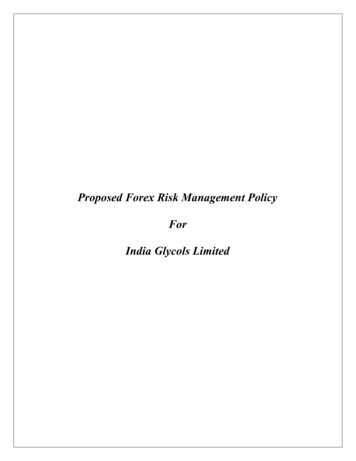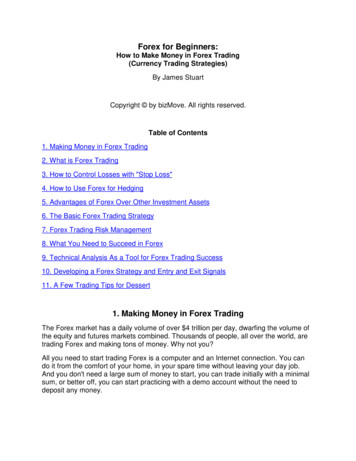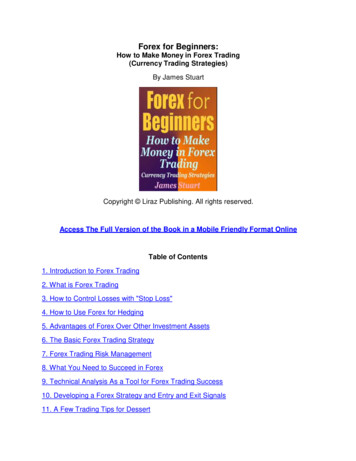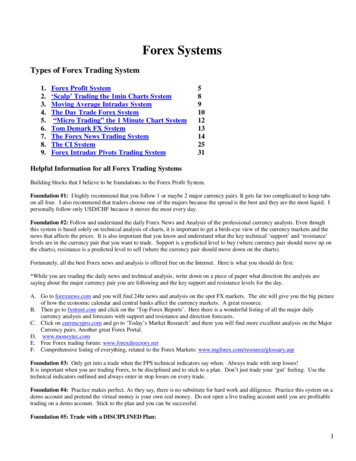
Transcription
Proposed Forex Risk Management PolicyForIndia Glycols Limited
Table of ContentsRATIONALE FOR THIS DOCUMENT.1EXPOSURES FACED BY IGL.2A. Translation Exposure.2B. Transaction Exposure.2VARIOUS TYPES OF FOREX RISK .4ORGANIZATIONAL FLOW.6HEDGING POLICY.9Definition of Hedging.9Importance and objective of Hedging.9Rules for Hedging.10Basic Hedging Instruments permitted as per IGL’s Risk Management Policy.10Parties to a hedge.10Hedging Ratio.11Selling of Local Foreign Currency Exposure.11hreshold amount for hedges without consultation.11The procedure for a hedging deal.12Decision Tree for a Hedging Decision.12RISK MAPPING PROCESS.13.14Actual & Booked Exposure.15Actual & Booked Exposure.18BASIC HEDGING INSTRUMENTS .20DECISION TREE FOR A HEDGING DECISION.22Forex Risk Management PolicyRATIONALE FOR THIS DOCUMENTIndia Glycols Ltd. (IGL) having exposures on account of exports, imports, income andexpenditure in one or more foreign currencies is affected by currency movements, interest ratemovements etc. This often implies a degree of uncertainty in terms of the effect on financialresults and the company’s ability to execute transactions on future dates with similar profit levelsas envisaged at the onset.The purpose of this document is to Outline the risk management practices in the market and the basis on which company shouldprotect itself against unfavorable foreign currency and interest rate movements. To define the roles and responsibilities within the company with respect to its CorporateHedging Policy.Forex Risk Management Policy-1-
To prescribe general guidelines for day to day operations and to help understand the variousaspects of a treasury on the basis of hypothetical examples.EXPOSURES FACED BY IGLThe functional currency of Indian corporate is the Indian Rupee (INR). The combination of theforeign currency and the functional currency is named a “currency pair”, for instance, USD/INR.There are two types of currency exposures:A.Translation ExposureThis exposure represents long-term investments of the company in foreign entities i.e., the equityheld at these entities, but it can also include other methods of financing which have an equity-likecharacter. The economic effects of an exchange rate change relate to the net investment in thatentity. Translation adjustments that arise from consolidating that foreign entity do not impactcash flows and are not included in the net income, but are disclosed and accumulated in a separatecomponent of the consolidated equity (that is, until sales or liquidation of the net investment insuch foreign entity takes place).India Glycols Ltd. (IGL) has equity holding in ABC Ltd., New York worth USD 10 Mio. Ason 31.12.2005 at the rate of Rs.45/USD, the investment would be worth Rs.45 crs.If the Rupee were to appreciate to Rs.43/USD, then the value of the investment in IGL‘sbalance sheet would become Rs.43 crs, a fall of Rs.2 crs in the value of the investment.This would represent Translation Exposure.Sometimes the financial markets refer to “translation effects” on income statement positions, suchas the foreign currency impact on sales. In order to distinguish between the translation exposure,as defined above in this policy, and the impact on the income statement, we shall refer to theeffects on the income statement as “conversion effect”.B.Transaction ExposureA foreign currency transaction is one that is denominated or requires settlement in a differentcurrency than INR. The economic effects of an exchange rate change will impact the cash flowdirectly and are, therefore, included in the net income.The cash flows of each foreign currency over a period of time (e.g. 12 months) are described asthe “currency exposure” of the company for that period of time.There are four types of transaction exposures: Booked exposureForex Risk Management Policy-2-
Any outstanding (or not yet settled) foreign currency transaction is defined as a foreign currencyexposure in the book of the reporting entity (e.g. an outstanding US-Dollar account receivable inIndian Entities’ books). The difference between the exchange rate used when recording thisforeign currency transaction and the exchange rate used to re-value it in the balance sheetrepresents the gain or loss of the foreign currency transaction.IGL has receivables on account of exports worth USD 50 Mio which @ Rs.45/USD as on31.12.2005 translates intoRs.225 crs.A change of rate to Rs.43/USD would change the receivables Rs.215 crs, a negative cashflow of Rs.10 crs.This would represent a Booked Exposure. Economic ExposureAs business becomes increasingly global, exchange rate changes (volatility) become moreimportant, even for a purely domestic firm operating in a global market. Firms have to pay moreattention to exchange rate risk, and devise hedging strategies to manage and control currency risk.Even a purely domestic firm, using only domestic parts (no imports), selling only in the domesticmarket (no exports), all payables and receivables in local currency, is bound to be affected bychanges in exchange rates.IGL exports towels to USA. There is a competitor from China who is also exporting thesame product to USA. Even if the rupee-dollar levels remain unchanged, and the Yuandepreciates against the dollar, the company in China would be in a position to offer the sameproduct at more competitive rates to the buyer in the US, thus putting IGL at a disadvantage.This represents Economic Exposure. Local Foreign Currency ExposureThis represents the liquidity or cash holdings (net of overdraft) held in a currency other than INR.This would typically mean foreign currency accounts being maintained in banks within India. Asin the case for the “booked exposure”, the movement in the exchange rate of cash holdings andequivalents held in a foreign currency will represent a gain or loss of the foreign currency assetand to that extent would also affect the liquidity position of the company.IGL. has an EEFC (Exchange Earner’s Foreign Currency) Account with State Bank of India,Ludhiana. The balance of the account is USD 1.0 Mio, which as at 31.12.2005 is valued at Rs.4.5 crs (@ Rs.45/USD).A change in the rate to Rs.43/USD would result in a loss of Rs.0.20 crs in the value of theamount held in the account.This represents Local Foreign Currency Exposure.Forex Risk Management Policy-3-
Anticipated or Expected ExposureThe anticipated or expected currency exposure represents highly probable future foreign currencysettlements of the Indian Entities which are not yet reflected in the book and, therefore, do notgenerate any exchange gains or losses in the financial statements. However, we can anticipatethem and their direct impact on the profitability in case of a movement in the exchange rates.The forecasted currency exposure arising from future sales and their corresponding collectionof the account receivables of IGL would represent Anticipated or Expected Exposure.VARIOUS TYPES OF FOREX RISKRisk has two components, exposure and uncertainty. This uncertainty would be on account ofunpredictability of future events. Based on the exposures faced by IGL, the various risks facing itare:Exchange Rate RiskThe risk arising on account of movement in the exchange rates of all relevant currencies wherethe company has exposure in terms of Foreign currency denominated cash flows; and/orForeign currency denominated assets/liabilitiesAnalyzing the financial impact arising from potential positive or negative exchange ratemovements on the currency exposure can help assess this risk. The outcome of this analysis canthen determine which foreign currencies should be tracked and monitored on an ongoing basis.In the case of IGL, if money must be converted into a different currency to make a certaininvestment, changes in the value of the currency relative to the American dollar will affectthe total loss or gain on the investment when the money is converted back.This would expose the company to exchange rate risk.The financial impact due to potential changes of exchange rates has to be quantified for eachforeign currency exposure separately. The risk has to be quantified based on the shift of the spotexchange rates at the time of the analysis according to the volatility of the currency pair.The evaluation shall be done based on the total booked and anticipated transaction exposures (nonetting of outstanding hedge deals) for the next 12 months (rolling).Interest rate riskForex Risk Management Policy-4-
Interest rate movement in India and the dollar market can pose a risk when the company has anexposure to Long-term foreign currency assets/liabilities; and/orLong-term rupee assets/liabilitiesLet us suppose IGL has fixed interest rate loan @ 8% p.a. If during its tenure thefloating interest rate goes down then IGL will be in disadvantage.This exposes the company to interest rate risk. This can be mitigated by entering into fixed tofloating interest rate swap.There is always a possibility of a reduction in the value of a security, especially a bond, resultingfrom a rise in interest rates. This risk can be reduced by diversifying the duration of the fixedincome investments that are held at a given time. This is often referred to as Risk Diversification.Let us suppose IGL has invested today in a one-year Rs.100 bond at 8% p.a. If duringthe year the interest rates go up to 9%, the value of the bond will go down to Rs.99.0825 (108/1.09), from Rs.100.This exposes the company to interest rate risk.OBJECTIVES FOR THE FOREX RISK MANAGEMENT POLICYThe broad objectives of this document are: To identify the Forex risks the company is exposed to due to the nature ofbusiness activity To decide the process of management of these risks through a variety of riskmanagement tools To establish processes to monitor and control the risks as per the process To create an efficient process for reporting the key parameters measuring the risksand the performance of the Risk Management ToolsThe process also covers the proposed authority and responsibility structure and is meant to coverall activities of the company with regards to management of Foreign exchange as well as interestrate risks.Forex Risk Management Policy-5-
ORGANIZATIONAL FLOWFor the purpose of the forex operations the organizational hierarchy levels would beRisk ManagementCommitteeCMDPresident (Finance)/CFOCEOThe constitution and functions of each of the hierarchy levels would be defined as below:1. Risk Management Committee:The Risk Management Committee is set up for reviewing the treasury and forexoperations. This committee would be formed with the following objectives: Reviewing the current exposure of the company Reviewing & reporting on the risks facing the company Reviewing the entire forex operations. Reviewing Trigger Levels. Defining the authorization levels. Defining the hedging ratio range, the rules to be followed for hedging purposes bycompany and the mechanisms to be followed with respect to hedging decisions Authorizing the hedging instruments which can and should be used by companyfor hedging purposes. Maintaining control framework. Maintaining the Budget (USD/INR) for all Imports and Exports.This committee may further create sub-committees, if desired, for assignment of specificresponsibilities.The Constitution of the committee would be as under:Chairman & Mg Director (CMD)Chief Executive Officer (CEO)President (Finance)/CFOForex Risk Management Policy-6-
Any other management personnel / Consultant whom the RMC will nominate for thispurpose. However the RMC will submit its report to the Board of Directors on Quarterlybasis.Quorum –The RMC would have a quorum so as to ensure its regular functioning. The followingwould be treated as a quorum.1. Chairman & Mg Director (CMD)The CMD would be overall in-charge and the chairman of the the Risk ManagementCommittee. He would ensure that the guidelines laid down by the RMC are beenfollowed by the treasury.2. . Chief Executive Officer (CEO)The CEO would assume authority for the overall performance of the treasury operationsas well as he would ensure that the guidelines laid down by the RMC are been followedby the treasury.3. President Finance/CFO: (Treasury Head)The CFO would assume authority and responsibility for the overall performance of thetreasury operations (Front office/ Back Office). He would be the link between the BanksTreasury and the RMC. The functional responsibilities of the treasury head could beoutlined in terms of criticality of function and materiality.Issue of Deal Confirmation to banks:CMD / CEO will be authorized to issue the deal conformation to the bank. However VicePresident (F&A) and the Co Secy is also authorized (singly) to issue the dealconfirmation to the bank.Critical Functions:The treasury head would be responsible for the following activities and any action on thesame would require his approval:a. Change in Policy: Any decisions concerning change in policy parameters likerecognition, benchmarking, stop loss, etc would require concurrence of the CMD.The CMD could suo moto or on the recommendation of the CFO may considerthese changes and can approve the same.Forex Risk Management Policy-7-
New Product Approval: Any new products desired to be done by the treasuryshould require the prior approval of CMD and the Board of Directors.c. Increase in pre set limits: Any increase in the monetary caps on exposure shouldrequire the approval of the CMD.d. Personnel requirements and reorganizations: These functions would comeunder the purview of the head of treasury/ CFO and could be decided by them.b.Materiality:Not withstanding anything mentioned above, any transaction which exceeds a materialitythreshold decided by the treasury should require the prior approval of the treasury head.4. Front Office / Back Office Desk:The front office desk is the heart of the treasury function. The primary objectives of thefunction desk are defined as follows:a. Track International Forex Movementsb. Hedge Exposures within the FX guidelinesc. Directional Positioningd. Execution of decisions laid down within the parameters of the RMCe. Execute trades whenever any stops or take profits are triggered.f. Tracking Regulatory changes and updationThe back office desk would be the support function for all the hierarchy levels. Thefunctions of this desk would be as follows:a. Data assimilation from all user departmentsb. Updating of the MISc. Reconcile the deals executed by the Front office Deskd. Generation of MIS reports for various hierarchy levelse. Reporting by exceptionf. Recording the Forex transaction in the books of accountsThe Constitution of the Front Office Desk would be as under:Chief Dealer:He would the head of the Front office Desk. All the nominated dealers would report tohim. Over and above the primary objectives listed, the functions of the Chief Dealerwould also include:a.b.Authorization for various actions carried out by the DealersReporting exceptions to the Head TreasuryDealers:Forex Risk Management Policy-8-
It would include the nominated dealers who would operationally carry out the functionsdefined above.The Constitution of the Back Office Desk would be as underHead MIS:He would the head of the Desk. All the nominated personnel in the MIS departmentwould report to him.Personnel:These personnel would be the one who on a day-to-day basis perform all the abovefunctions.HEDGING POLICYDefinition of HedgingA hedge is defined as an action taken in order to reduce the risk of adverse price movements in asecurity, by taking an offsetting position in a related security, such as an option or a short sale.These would include measures, such as deployment of financial instruments, for the purpose ofsafeguarding the value of a foreign currency exposure.Importance and objective of HedgingThe purpose of hedging is to reduce the unpredictability arising on account of exchange ratemovements and currency movements on cash flows, earnings and equity.The objective of hedging is to Minimize transaction and translation losses on balance sheet items; and toProtect the anticipated exposures and risks, in the process mitigating the impact on profitsThe RMC will issue Corporate Hedging Policy and will make rules and issue guidelines on thefollowing subjects, among other things: Rules for hedgingBasic Hedging Instruments permitted by the companyParties to a hedgeHedging RatioSelling of Local Foreign Currency ExposureThreshold amount for hedges without consultationThe procedure for a hedging dealDecision Tree for a hedging decisionForex Risk Management Policy-9-
Rules for HedgingA hedging transaction should be done keeping in mind the following guidelines: The hedging instruments used and procedure for transacting deals should have been approvedby the RMC.There should be local know-how of the hedging instrument.It should be possible to evaluate the deal as per the ‘marked-to-market’ concept in case ofneed and should be reported in accordance with the guidelines of the Hedging Policy.The hedging deals should be reported as per pre-defined reporting rules, regardless of theresponsibility or hedged amount or duration of the hedge.The decision to hedge or not to hedge should be made keeping in mind the Hedging Ratio1 ofthe company.However, hedging should not be done permanently and automatically as in most circumstancesthe associated hedging costs would be expensive. Hedging should be carried only after thefollowing things have been taken care of There has been an assessment of the key currencies to track and exposures to hedgeThere is a mechanism in place, which allows real-time monitoring of market conditions so asto allow the company to take advantage of favorable market development while minimizingthe costs of hedging.Basic Hedging Instruments permitted as per IGL’s Risk Management PolicyThe company approves the following hedging instruments for the purpose of hedging currencyand interest rate risks: Spot TransactionsFX Forward Contracts for covering Export/Import for USD/INR dealsPrincipal Only SwapsInterest Rate SwapsFor detailed explanation and examples on the above-mentioned, refer Annexure 1.Parties to a hedgeThe company must follow the rules, laid down by the Hedging Policy, regarding the parties withwhich the company can enter into a hedging transaction. However the following specificationshave been laid down for the same: Hedging deals should only be done between the company and an authorized dealer(preferably a bank). The selection of a bank for this purpose should be from the RMCapproved list of banks. No hedging transactions should take place between the Finance department and divisionsand/or business units.1The Hedging Ratio is defined as the total amount hedged divided by the sum of booked and anticipatedexposures. The adherence to this ratio is normally at the level of a currency pair and is valid by month.Forex Risk Management Policy- 10 -
Hedging RatioA hedging ratio is described, as the ratio of number of forward/option contracts needed to hedge aposition in the underlying instrument. Technically, it is defined as the total amount hedgeddivided by the sum of booked and anticipated exposures. The hedging ratio range of the sum of booked and anticipated exposures for a pre-decidedtime frame defines the framework for deciding to hedge or not to hedge.The hedging ratio is defined by the RMC and has to be adhered to by the company at thelevel of the relevant currency pairs.The following hedging ratio ranges have been suggested for broad guidelines:Type of Exposure Booked ExposureForPayables/Receivables0 - 12 monthsMaximumpermissibleHedging Ratio80% to 100%Booked Exposure 1 Year50% to 75%Anticipated Exposure0 - 12 months50%Anticipated Exposure 1 Year25%In case the above mentioned limits are required to be enhanced, then the approval from theRMC/CMD is required to be obtained.As long as the split between booked and anticipated exposures is not available, the hedgingratio range, as established for the anticipated exposure, will be applicable to the totalexposure.However all the above limits are subject to regulations of FEMA issued by RBI from time totime and no violation of the RBI regulations should be done. FEMA regulations willsupersede notwithstanding anything contrary mentioned in this document.Selling of Local Foreign Currency ExposureThe Hedging Policy must clearly specify the guidelines to be followed in the case of the selling ofLocal Foreign Currency Exposures.Illustration : IGL which has decided that cash holdings in foreign currencies (in EEFC account)by the company, that are not needed for payments within the following 60 days or for settlinghedging transactions must be sold within 7 days after clearance of the receipt by the bank.IGL, in its Hedging Policy, has also specified that the threshold amount for having to sell thebalance of liquidity in foreign currency is USD 1 Mio, or equivalent in foreign currency.hreshold amount for hedges without consultationForex Risk Management Policy- 11 -
For the company to be able to hedge without prior approval from the CEO/ President (Finance),certain condition have to be met and certain limits to be followed.The conditions to be met are: All rules set by the Hedging Policy should be strictly adhered to. The parties to a hedge, and choice of hedging instruments should be dictated by the HedgingPolicy. All accounting and reporting standards should be adhered to.The limits would also have to be prescribed by the Hedging Policy. At the outset the followinglimits have been prescribed (per month basis): In case of exports against anticipated exposure, the Aggregate Face Value 2 of the amount inquestion should not exceed USD 10 Mio per month or equivalent in USD. In case of imports against anticipated exposure, the aggregate face value of the hedge shouldnot exceed USD 10 mio per month or equivalent in USD. In case of booked exposure, the aggregate value of the hedge in one month may be upto themaximum permissible hedging ratio.The procedure for a hedging dealThe responsibility for hedging above the amount specified as the threshold amount for hedgeswithout consultation by the company lies with the President (Finance), unless the companyobtains prior written permission from the same to hedge above the said specified amount. Every step of the process for a hedging deal must be in accordance with the guidelines, if any,set by the Hedging Policy, lay down by the RMC.Irrespective of the amount or the duration of the hedging deal, the ‘Rules for Hedging’specified earlier must be abided by.The hedging instrument must be as per ‘Basic Hedging Instruments’ permitted by theGroup Hedging Policy.It is the company’s responsibility to hedge, provided the parties being dealt with are as per‘Parties to a Hedge’ specified by the Hedging Policy.The ‘Hedging Ratio’ decided upon by the Hedging Policy must be kept in mind.Hedging deals done without prior approval must be in accordance with the ‘Thresholdamount for hedges without consultation’.The decision making process must be as per the ‘Decision Tree for a Hedging Decision’decided upon by the Hedging Policy. (Refer Annexure 2.)The reporting of the hedged deals must be as per the ‘Internal Reporting’ (described later)standards of the company.Decision Tree for a Hedging DecisionIGL follows a pre-determined process flow which must be followed by the company, when adecision needs to be taken regarding the hedging of some exposures and risks. This is depictedwith the help of a flow chart given in Annexure 2.2The Aggregate Face Value represents the sum or aggregate value of all hedging transactions in any givenmonth.Forex Risk Management Policy- 12 -
RISK MAPPING PROCESSA comprehensive risk-mapping process is needed which would cover the followingissues Legal compliance issues i.e. all potentialities which can create a situation for thecompany to overshoot legal guidelines Information technology i.e. keeping abreast with the latest developments in theindustry Keeping track of industry best practices to keep in touch with the best in the industry Regulatory requirements and compliance with company’s internal guidelines andlimits Competitor activity analysis i.e. keeping abreast with relevant competitor activity thatmight pose a risk to the company’s business Reputation i.e. mapping all potential risks for the company in terms ofmaintaining/enhancing its reputation in the business Business interruption i.e. mapping all potential threats to the smooth-functioning ofthe organization, operationally or otherwise1. Risk Management Process for Current Account ExposuresThe following would be considered as current account transactions for the RiskManagement Process:1.Imports2.Exports3.Any other exposures falling due within a period of one year.1.1 Recognition1.Imports Exposures would be considered on a rolling twelve month period basis All projected exposures would be recognized from the first day of the monthwhen they are projected All actual exposures would be recognized on the basis of confirmed order/ LCopening date. Projections would be adjusted for the actual exposures2. Exports Exposures would be considered on a rolling twelve month period basisAll projected exposures would be recognized from the first day of the monthwhen they are projectedAll actual exposures would be recognized on the basis of confirmed order withparticulars of shipment & payment terms.Projections would be adjusted for the actual exposuresForex Risk Management Policy- 13 -
3. Any other exposures falling due within a period of one year – In case of exposureswhere projections could be made in advance, such projections to be made on the firstday of the month of every month rollover. In other cases the exposure would berecognized on the first day when the information is available about the same.1.2 Benchmark:1. Imports – For the projections the benchmark for each month would be the First DayForward Rate for the delivery month i.e. if the foreign currency is in premium in theforward market, then the applicable premium would be up to the last day of that monthand if the foreign currency is in discount in the forward market, then the applicablediscount would be till the first day of that month. In case of spill over in due date to nextor previous month, Benchmark to be adjusted for swap differentials.2. Exports – For the projections the benchmark for each month would be the First DayForward Rate for the delivery month i.e. if the foreign currency is in premium in theforward market, then the applicable premium would be till the first day of that month andif the foreign currency is in discount in the forward market, then the applicable discountwould be up to the last day of that month. In case of spill over in due date to next orprevious month, Benchmark to be adjusted for swap differentials.3. Any other exposures falling due within a period of one year – The benchmark wouldbe the First Day Forward Rate on the first day of recognition of exposure.1.3 Profitability Measurement:The Treasury function will be evaluated on the basis of the Transfer Pricing Method i.e.the comparison of the benchmark rate and the actual realization/ payment rate.1.4 Quantification of Risk: Risk - Reward Trigger levels:IGL has defined its risk reward relat
1. Risk Management Committee: The Risk Management Committee is set up for reviewing the treasury and forex operations. This committee would be formed with the following objectives: Reviewing the current exposure of the company Reviewing & reporting on the risks facing the company Reviewing the entire forex operations. Reviewing .











